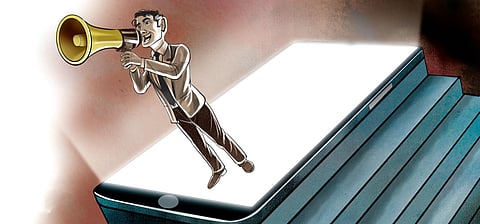

What Osama Bin Laden did to the security products and services industry, the corona pandemic has done to the digital products and services category. Digital products, services and app-led selling, advertising, marketing, PR, etc., are the reality of new advertising and marketing.
When I look at advertising as we know it, I see a sure change making rapid strides. This time round, it is not the rabid cry of the digital industry wanting to be heard and acknowledged, a PR-pushed top-down shout to get the digital industry take those important evangelical first steps in a new market. Instead, it is the sure-footed march of digitalism in our lives, as demanded by the consumer. And that makes this a trend not to ignore. The consumer seems to want it. And what the consumer wants, the consumer gets. As usual. Water finds its own level. So does digitalism in our new lives of the new day.
The current pandemic and the nine months of the fear economy that had us cooped up in our houses with successive sets of government-imposed lockdowns and later self-imposed fear-led rules have given the movement of digital advertising and marketing a big fillip.
When I look into the media plans of brand-led organisations, it is not a surprise that digital advertising is gobbling up bigger and bigger shares of the pie of advertising, as we knew it in the good old days.The year 2019 and its heady advertising spends in traditional mediums seem so far away. In one stroke, and in one sweepingly large swathe of the pandemic, there is a redefinition of sorts when I look at the marketing and advertising industry.
While the numbers are looking good for advertising by and large, they are really looking great for the digital side more than ever before. If the prognosis for the year 2020 is believed to touch Rs 86,000 crore, the breaking news is that digital advertising is gobbling up as much as 85% of the incremental revenue growth. Digital advertising promises to emerge in the number two position after television, with a 31% share of the pie.
Advertising as we knew it is changing. The impact of advertising along with its allure gets bigger and deeper as people lead insular lives within their homes or within the safe bubbles of their own creation. Outdoor life is today more a necessity, rather than one jumped into out of sheer volition. It will remain that way for a while as IT and IT-enabled companies across the board make announcements that work-from-home is here to stay for many of them.
How has advertising changed then? I see seven distinct nudges to watch out for and take note of:
1. Old advertising was really a process that celebrated the aggregation of advertising. New advertising is all about disaggregation of advertising.The old norm was one creative agency and possibly four creative executions for a brand. And these creatives would hit the national network on television, print, radio, outdoor and even digital. They would last a while and then change.New advertising is totally disaggregated as opposed to the old. The very same brand has 40 macro-digital endorsers, and possibly 8,000 micro-creators. And that would mean 8,000-plus creatives out there. This is disaggregated advertising at its best.
2. In the era of old advertising, the handle of a brand was always with the brand manager and the brand organisation. Today, progressively, the brand handle is with thousands of creators, all carefully watched and curated. The brand gets closer to the consumer in terms of control. The consumer does not have this control in full as yet, but expect that to happen.
3. The era of the big celebrity endorser is ending rather fast. The micro-brand endorser is a reality. For the same price you paid for a big star, you now get possibly 200 of them.
4. Editorialising the advertising is what influencers and creators achieve on social media. Advertising that does not look as advertising is the new soft norm. Brand messaging that does not look like brand messaging even.
5. We moved from the efficacy of 1:1 advertising and selling to 1:many through group meets, and finally to the 1:all format of television and mass media advertising. Today, it’s nearly back to 1:1 with fine-tuned efficacy metrics being delivered by digital.Top-down advertising is giving way to laterally led advertising with digital micro-creators doing peer-to-peer content with panache. And peer-to-peer messaging packs in it the trust quotient that brands crave for.
6. Top-down mass-media advertising had an issue in the old days. The advertising creative was one, if not five. They had to deliver a niche message to the masses of viewers. Out here, you had the option to position your messaging either to the lowest-common-denominator in the audience, the middle-common-denominator or the highest-common-denominator. The path of least resistance and acceptability seemed to be advertising that appealed to the lowest-common-denominator in the target audience. New advertising as attempted by the digital can approach each of these constituencies differently and seamlessly. In many ways digital advertising is an oxymoron, a ‘niche’ mass media of sorts!
7. And finally, the “nudge-to-act” factor in advertising is being explored differently through the new digital format. The nudge to action in terms of buying something is one that depends on timing. Exact and specific timing.Digital formats such as Instagram, Chingari and Roposo are able to time it that much better, and optimise and capitalise on the “nudge-to-act” moment. That 15-second short-format video on Instagram Reels may just be able to nudge you at the right moment to go online and click that buy button on that corona protective visor that excited you enough. And it happened at 3.46 am!
Harish Bijoor
Brand Guru & Founder, Harish Bijoor Consults
(harishbijoor@hotmail.com)